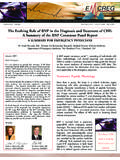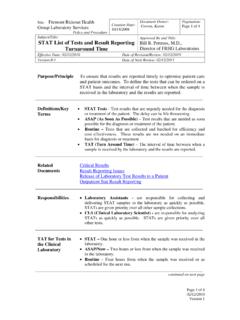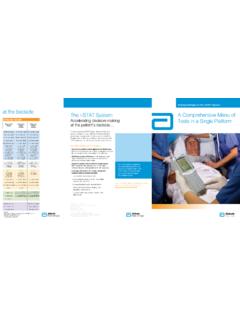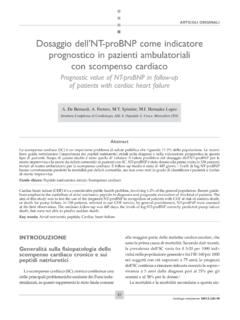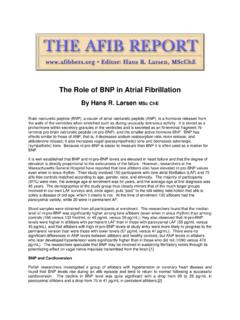Transcription of A Guide To AL (Light Chain) Amyloidosis
1 A Guide To AL ( light chain ) Amyloidosis Authored by Ravi Mareedu and Raymond Q. Migrino What is Amyloidosis ? Amyloidosis is a disorder in which misfolded native proteins de-posit extracellularly and lead to organ damage. Although the various types of amyloidoses share in common the deposition of misfolded proteins that aggregate as fibrils in tissue, they differ in actual protein composition, organ involvement, prognostic implication and most importantly, treatment. It is therefore critically important to determine the type of Amyloidosis a pa-tient has in order to provide the appropriate treatment.
2 There are at least 23 different proteins associated with amyloi-dosis. The most common type of Amyloidosis and the one that is associated with a poor prognosis if left untreated is called AL Amyloidosis and due to the deposition of clonal immunoglobu-lin light chains produced by plasma cells in the bone marrow. There are several types of hereditary amyloidoses, most com-mon of which is mATTR Amyloidosis , an autosomal dominant disease that results from misfolding of mutant transthyretin, a protein produced in the liver containing a single point gene mu-tation.
3 More than 100 different transthyretin mutations are known to cause Amyloidosis . The wild-type transthyretin can also misfold and aggregate as amyloid fibrils in tissues, usually the heart in the elderly Caucasian men, causing wtTTR amyloido-sis (also called senile systemic Amyloidosis ). Other types of amyloidoses include the following. Chronic in-flammatory conditions such as rheumatoid arthritis or chronic infections (such as bronchiectasis) are associated with excessive production of the inflammatory protein, serum amyloid A (SAA) that may misfold and lead to AA Amyloidosis .
4 Misfolding and amyloid deposition of atrial natriuretic peptide may lead to AANP Amyloidosis located in the left atrium and increase the risk of atrial fibrillation. Other mutant proteins causing hereditary amyloidoses include apolipoproteins AI and AII, cystatin C, fi-brinogen A - chain , lysozyme, and gelsolin. This pamphlet will concentrate on the most common type of Amyloidosis , AL ( light chain ) Amyloidosis with special emphasis on the cardiac findings. For further reference on ATTR amyloido-sis, please refer to a similar pamphlet from the Amyloidosis Foundation on this topic.
5 What is AL ( light chain ) Amyloidosis ? AL Amyloidosis is the disease caused by abnormal immunoglobu-lin light chains (LCs) produced by clonal plasma cells in the bone marrow. The abnormal LCs subsequently misfold, aggregate, and deposit in tissues as amyloid fibrils. It is part of a spectrum of clonal plasma cell proliferative disorders that include multiple myeloma, monoclonal gammopathy of undetermined signifi-cance, Waldenstrom s macroglobulinemia and heavy chain dis-ease. Multiple myeloma is associated with an excessive number of bone marrow plasma cells (30% or more) producing immu-noglobulin proteins, however, only about 10-15% of patients with multiple myeloma develop AL Amyloidosis .
6 Patients with AL Amyloidosis usually have only a modest increase in the popula-tion of plasma cells (5-20%) in the bone How common is AL Amyloidosis ? Although AL Amyloidosis is commonly thought of as a rare dis-ease, the incidence is similar to diseases not considered rare such as Hodgkin s disease or chronic myelocytic leukemia. There are approximately 2000-2500 new cases per year in the United States. Increased awareness of the associated physical findings in Amyloidosis by physicians and the better technology at the present time for recognition of LC abnormalities in blood and urine is leading to the diagnosis of AL Amyloidosis at an earlier stage.
7 How do abnormal light chains cause pathology? Several mechanisms probably play a role in tissue and organ in-jury caused by abnormal LCs. LC proteins produced by the clonal plasma cell are structurally unstable and transition through a se-ries of intermediate conformations (monomers, dimers, oli-gomers) eventually attaining a non-native assembly that favors self-aggregation in tissues. Several factors have been implicated as contributing to the predisposition to form amyloid fibrils in-cluding specific amino acid substitutions, thermodynamic insta-bility and post-translational protein modifications.
8 The mass of amyloid deposits limits the ability of the tissue to function nor-mally. In addition, the deposition of amyloid proteins in the ex-tracellular space including the perivascular space in organs such as the heart, liver, gastrointestinal tract, kidneys and peripheral nerves is associated with evidence of apoptotic injury and oxida-tive stress. Perivascular deposition in arterioles is associated with ischemic injury in the setting of occlusive disease but is also seen even without flow limiting stenosis. Evidence from cell cul-ture studies, animal studies and clinical changes in patients fol-lowing chemotherapy suggest that circulating amyloidogenic light chains (not yet deposited as fibrils) have a toxic effect and cause direct tissue injury.
9 What organ systems are affected by AL Amyloidosis ? AL Amyloidosis is a systemic illness and can affect nearly every organ, including the heart, kidneys, lung, gastrointestinal system (liver and intestines), peripheral and autonomic nerves, and soft tissues. The presence of cardiac involvement and heart failure connotes the worst prognosis. Recent data from cardiac MRI suggests that about 3/4 of patients with AL Amyloidosis have car-diac involvement. What are the common manifestations of AL Amyloidosis ? Patients most frequently present with signs and symptoms of cardiac or renal disease.
10 Proteinuria is a common initial finding, often associated with nephrotic syndrome and severe edema. Symptoms of heart failure, such as dyspnea on exertion or at rest and orthopnea are also common. These may be accompa-nied by signs of right heart failure such as peripheral edema. The patient may complain of chest discomfort or chest pain, both typical and atypical of angina-like pain. This may be related to impaired myocardial flow reserve associated with small vessel perivascular involvement even in the absence of significant oc-clusive epicardial coronary stenosis.


